- HOME
- Enzyme List
- MAD-211 MALATE DEHYDROGENASE
MAD-211
MALATE DEHYDROGENASE from Microorganism

PREPARATION and SPECIFICATION
| Appearance | Slightly yellowish amorphous powder, lyophilized | |
|---|---|---|
| Activity | GradeII 40 U/mg-solid or more | |
| Contaminants | Glutamate oxaloacetate transaminase | ≤ 1.0×10-3 % |
| Lactate dehydrogenase | ≤ 1.0×10-3 % | |
| NADH oxidase | ≤ 1.0×10-3 % | |
PROPERTIES
| Stability | Stable at −20 ℃ for at least one year (Fig.1) |
|---|---|
| Molecular weight 1) | approx. 140,000 |
| Isoelectric point 2) | pH 4.8±0.1 |
| Michaelis constants 3) | 5.4×10-5 M (L-Malate), 5.0×10-6 M (Oxaloacetate), 8.1×10-6 M (NADH) |
| Structure | 4 subunits per enzyme molecule |
| Inhibitors | Hg2+ |
| Optimum pH | 8.0 (Fig.2) |
| Optimum temperature | 70 ℃ (Fig.3) |
| pH Stability | pH 3.0−9.0 (25 ℃, 20 hr) (Fig.4) |
| Thermal stability | below 70 ℃ (pH 7.5, 15 min) (Fig.5) |
| Effect of various chemicals | (Table 1) |
APPLICATIONS
This enzyme is useful for enzymatic determination of L-malate and glutamate oxaloacetate transaminase (GOT) in clinical analysis.
ASSAY
Principle

The elimination of NADH is measured at 340 nm by spectrophotometry.
Unit definition
One unit causes the oxidation of one micromole of NADH per minute under the conditions detailed below.
Method
Reagents
| K-phosphate buffer, pH 7.5 | 0.1 M |
|---|---|
| Oxaloacetate solution | 15 mM[2.0 mg oxaloacetic acid (MW=132.1)/mL of ice-cold K-phosphate buffer (A). This reagent is rather unstable and should be stored in an ice-bath during use](Should be prepared fresh) |
| NADH solution | 6.0 mM[4.25 mg NADH・Na2 (ORIENTAL YEAST, MW=709.4)/mL of H2O] (Should be prepared fresh) |
| Enzyme diluent | 0.1 M K-phosphate buffer, pH 7.5 contg. 0.2 % BSA |
Procedure
1.Prepare the following reaction mixture in a cuvette (d = 1.0 cm) and equilibrate at 30 ℃ for approximately 5 minutes.
| 2.80 mL | Potassium phosphate buffer, pH 7.5 | (A) |
|---|---|---|
| 0.10 mL | Oxaloacetate solution | (B) |
| 0.10 mL | NADH solution | (C) |
| Concentration in assay mixture | |
|---|---|
| Potassium phosphate buffer | 97 mM |
| Oxaloacetate | 0.49 mM |
| NADH | 0.20 mM |
2.Add 0.05 mL of the enzyme solution* and mix by gentle inversion.
3.Record the decrease in optical density at 340 nm against water for 3 to 4 minutes with a spectrophotometer thermostated at 30 ℃, and calculate the ΔOD per minute from the initial linear portion of the curve (ΔOD test).
At the same time, measure the blank rate (ΔOD blank) using the same method as the test except that the enzyme diluent is added instead of the enzyme solution.
*Dissolve the enzyme preparation in ice-cold enzyme diluent (D), dilute to 0.05−0.5 U/mL with the same buffer and store on ice.
Calculation
Activity can be calculated by using the following formula :
Volume activity (U/mL) =
-
ΔOD/min (ΔOD test−ΔOD blank)×Vt×df
6.22×1.0×Vs
= ΔOD/min×9.807×df
Weight activity (U/mg) = (U/mL)×1/C
| Vt | : Total volume (3.05 mL) |
| Vs | : Sample volume (0.05 mL) |
| 6.22 | : Millimolar extinction coefficient of NADH under the assay condition (cm2/micromole) |
| 1.0 | : Light path length (cm) |
| df | : Dilution factor |
| C | : Enzyme concentration in dissolution (c mg/mL) |
REFERENCES
Table 1. Effect of Various Chemicals on Malate dehydrogenase
[The enzyme solution dissolved in 0.1 M K-phosphate buffer, pH 7.5 contg. 0.2 % of BSA (17 U/mL) was incubated with each chemical at 25 ℃ for 1 hr.]
-
Chemical Concn.(mM) Residual
activity(%)None - 100 Metal salt 2.0 MgCl2 100 CaCl2 100 Ba(OAc)2 101 FeCl3 102 CoCl2 100 MnCl2 102 ZnSO4 99 Cd(OAc)2 94 NiCl2 100 CuSO4 99 Pb(OAc)2 99 AgNO3 98 HgCl2 0 NEM 2.0 100 MIA 2.0 99 -
Chemical Concn.(mM) Residual
activity(%)2-Mercaptoethanol 2.0 102 PCMB 0.1 100 IAA 2.0 99 Hydroxylamine 2.0 98 EDTA 5.0 99 o-Phenanthroline 2.0 99 α,α′-Dipyridyl 2.0 100 Borate 5.0 99 NaF 2.0 98 NaN3 2.0 98 Triton X-100 0.10 % 99 Brij 35 0.10 % 98 Tween 20 0.10 % 98 Span 20 0.10 % 97 Na-cholate 0.10 % 98 SDS 0.05 % 95 DAC 0.05 % 96
Ac, CH3CO; NEM, N-Ethylmaleimide; MIA, Monoiodoacetate; PCMB, p-Chloromercuribenzoate; IAA, Iodoacetamide; EDTA, Ethylenediaminetetraacetate; SDS, Sodium dodecyl sulfate; DAC, Dimethylbenzylalkylammonium chloride.
-
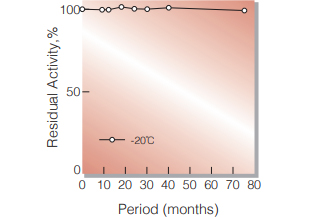
Fig.1. Stability (Powder form)
(kept under dry conditions)
-
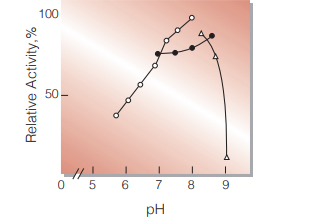
Fig.2. PH-Activity
30℃, in 0.1 M buffer solution:
pH 5.5-8.0, K-phosphate:pH 7.0-8.5, Tris-HCI; pH 8.0-9.0, Borate -
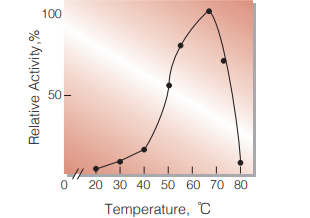
Fig.3. Temperature activity
(in 0.1 mM K-phosphate buffer, pH 7.5)
-
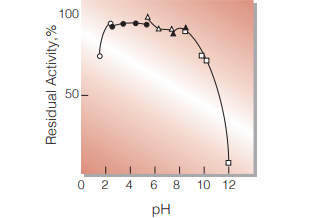
Fig.4. pH-Stability
25 ℃,20 hr-treatment with 0.1 M buffer solution:
pH 2.0-3.5,glycine-HCI; pH 3.0-6.0,acetate;
pH 6.0-8.0,K-phosphate; pH 8.0-9.0, Tris-HCI; pH 8.5-12.0,borate -
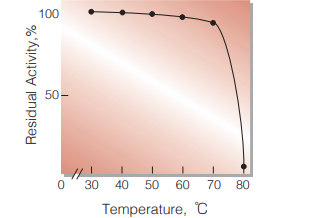
Fig.5. Thermal stability
15 min-treatment with 0.1 m K-phosphate buffer,pH 7.5 enzyme concentration:4.0 U/mL
活性測定法(Japanese)
1. 原理

NADHの減少を340nmにおける吸光度の変化で測定する。
2.定義
下記条件下で1分間に1マイクロモルのNADHを酸化す る酵素量を1単位(U)とする。
3.試薬
- 0.1M K-リン酸緩衝液, pH7.5
- 15mMオキサロ酢酸溶液〔2.0mgのオキサロ酢酸 (MW=132.1)を予め氷冷したK-リン酸緩衝液 (A)1.0 mLに溶解する〕(この試薬はかなり不安定で ある故,使用時も氷冷保存する)
- 6.0mM NADH水溶液〔4.25mgのNADH・Na2(オ リエンタル酵母製,MW=709.4)を蒸留水1.0 mLに 溶解する〕(用時調製)
酵素溶液:酵素標品を予め氷冷した0.2 %牛血清アル ブミンを含む50mM K-リン酸緩衝液,pH7.5 で溶解し,同緩衝液で0.05〜0.5U/mLに希 釈して氷冷保存する。
4.手順
1.下記反応混液をキュベット(d=1.0cm)に調製し,30℃ で約5分間予備加温する。
| 2.80 mL | K-リン酸緩衝液 | (A) |
| 0.10 mL | オキサロ酢酸溶液 | (B) |
| 0.10 mL | NADH水溶液 | (C) |
2.酵素溶液0.05 mLを添加し,ゆるやかに混和後,水を対 照に30℃に制御された分光光度計で340nmの吸光 度変化を3~4分間記録し,その初期直線部分から1分 間当りの吸光度変化を求める(ΔOD test)。
3.盲検は反応混液①に酵素溶液の代りに酵素希釈液 (0.2 %牛血清アルブミンを含む50mM K-リン酸緩衝 液,pH 7.5)を0.05 mL加え,上記同様に操作を行って1 分間当りの吸光度変化を求める(ΔOD blank)。
5.計算式
U/mL =
-
ΔOD/min (ΔOD test−ΔOD blank)×3.05(mL)×希釈倍率
6.22×1.0×0.05(mL)
| = ΔOD/min×9.807×希釈倍率 | |
| U/mg | = U/mL×1/C |
| 6.22 | : NADHのミリモル分子吸光係数 (cm2/micromole) |
| 1.0 | : 光路長(cm) |
| C | : 溶解時の酵素濃度(c mg/mL) |
CONTACT
-
For inquiries and cosultations regarding our products, please contact us through this number.
- HEAD OFFICE+81-6-6348-3843
- Inquiry / Opinion
